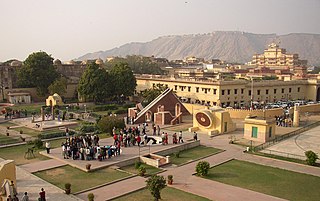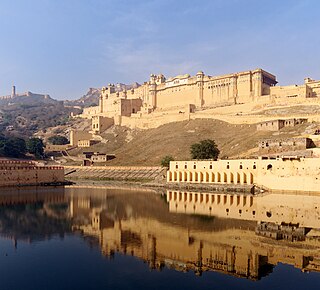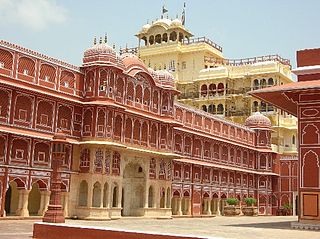
Amber or Amer, is a city near Jaipur city in Jaipur district in the Indian state of Rajasthan. It is now a part of the Jaipur Municipal Corporation.

Jaipur, formerly Jeypore, is the capital and largest city of the Indian state of Rajasthan. As of 2022, the city had a population of 4.5 million, making it the tenth most populous city in the country. Jaipur is also known as the Pink City, due to the dominant colour scheme of its buildings. It is also known as the Paris of India, and C. V. Raman called it the Island of Glory. It is located 268 km from the national capital New Delhi. Jaipur was founded in 1727 by the Kachhwaha Rajput ruler Jai Singh II, the ruler of Amer, after whom the city is named. It was one of the earliest planned cities of modern India, designed by Vidyadhar Bhattacharya. During the British Colonial period, the city served as the capital of Jaipur State. After independence in 1947, Jaipur was made the capital of the newly formed state of Rajasthan.

Jai Singh II popularly known as Sawai Jai Singh was the 29th Kachwaha Rajput ruler of the Kingdom of Amber, who later founded the fortified city of Jaipur and made it his capital. He was born at Amber, the capital of the Kachwaha Rajputs. He became ruler of Amber at the age of 11 after the death of his father, Raja Bishan Singh on 31 December 1699.

The Hawa Mahal is a palace in the city of Jaipur, India. Built from red and pink sandstone, it is on the edge of the City Palace, Jaipur, and extends to the Zenana, or women's chambers.

The Kachhwaha or Kachawa is a Rajput clan found primarily in India. Sometimes families within the clan ruled a number of kingdoms and princely states, such as Jaipur, Bihar, Uttar Pradesh, Madhya Pradesh, Alwar and Maihar.

The Jantar Mantar, Jaipur is a collection of 19 astronomical instruments built by the Rajput king Sawai Jai Singh II, the founder of Jaipur, Rajasthan. The monument was completed in 1734. It features the world's largest stone sundial, and is a UNESCO World Heritage site. It is near City Palace and Hawa Mahal. The instruments allow the observation of astronomical positions with the naked eye. The observatory is an example of the Ptolemaic positional astronomy which was shared by many civilizations.

Jantar Mantar is located in the modern city of New Delhi. “Jantar Mantar” it means “instruments for measuring the harmony of the heavens”. It consists of 13 architectural astronomy instruments. The site is one of five built by Maharaja Jai Singh II of Jaipur, from 1723 onwards, revising the calendar and astronomical tables. Jai Singh, born in 1688 into a royal Rajput family that ruled the regional kingdom, was born into an era of education that maintained a keen interest in astronomy. There is a plaque fixed on one of the structures in the Jantar Mantar observatory in New Delhi that was placed there in 1910 mistakenly dating the construction of the complex to the year 1710. Later research, though, suggests 1724 as the actual year of construction. Its height is 723 feet (220 m).

Amer Fort or Amber Fort is a fort located in Amer, Rajasthan, India. Amer is a town with an area of 4 square kilometres (1.5 sq mi) located 11 kilometres (6.8 mi) from Jaipur, the capital of Rajasthan. Amber city and Amber fort were founded by ruler Alan Singh of Chanda dynasty of Meenas. Located high on a hill, it is the principal tourist attraction in Jaipur. Amer Fort is known for its artistic style elements. With its large ramparts and series of gates and cobbled paths, the fort overlooks Maota Lake, which is the main source of water for the Amer Palace.

Jaigarh Fort is situated on the promontory called the Cheel ka Teela of the Aravalli range; it overlooks the Amer Fort and the Maota Lake, near Amer in Jaipur, Rajasthan, India. The fort was built by Sawai Jai Singh in 1726 to protect the Amer Fort and its palace complex and was named after him.

The Kingdom of Amber, alson known as Kingdom of Dhoondar and Jaipur State, was located in the Rajputana region of India and was ruled by the Kachhwaha clan. It was established by Dulha Rai, possibly the last ruler of the Kachchhapaghata dynasty of Gwalior who migrated to Dausa and started his kingdom there with the support of Chahamanas of Shakambhari in the 11th century. Mostly through 12th to 15th century, the kingdom faced stagnation sources are scarce. Under Chandrasen, it became a Sisodia vassal and fought in the Battle of Khanwa under Prithviraj Kachhwaha.

Fort Madhogarh is located in Madhogarh Village, 42 km from Jaipur off the Jaipur - Agra highway. Fort Madhogarh was built by Madho Singh Ji nearly 400 years ago and renovated and converted into a heritage hotel by Thakur Bhawani Singh Ji in July 2000.

The culture of Rajasthan includes many artistic traditions that reflect the ancient Indian way of life. Rajasthan is also called "Land of Kings". It has many tourist attractions and facilities for tourists. This historical state of India attracts tourists and vacationers with its rich culture, tradition, heritage, and monuments. It also has some wildlife sanctuaries and national parks.
The Royal Orient is an Indian luxury tourism train that runs between Gujarat and Rajasthan, covering important tourist locations in the two states.

The City Palace, Jaipur was established at the same time as the city of Jaipur, by Maharaja Sawai Jai Singh II, who moved his court to Jaipur from Amber, in 1727. Jaipur is the present-day capital of the state of Rajasthan, and until 1949 the City Palace was the ceremonial and administrative seat of the Maharaja of Jaipur. The Palace was also the location of religious and cultural events, as well as a patron of arts, commerce, and industry. It now houses the Maharaja Sawai Man Singh II Museum, and continues to be the home of the Jaipur royal family. The royal family has around 500 personal servants. The palace complex has several buildings, various courtyards, galleries, restaurants, and offices of the Museum Trust.The MSMS II Museum Trust is headed by chairperson Rajamata Padmini Devi of Jaipur. Princess Diya Kumari runs the Museum Trust, as its secretary and trustee. She also manages The Palace School and Maharaja Sawai Bhawani Singh School in Jaipur. She founded and runs the Princess Diya Kumari Foundation to empower underprivileged and underemployed women of Rajasthan. She is also an entrepreneur. In 2013, she was elected as Member of the Legislative Assembly of Rajasthan from the constituency of Sawai Madhopur.

Naruka is a clan of Rajputs found in India. Naruka Rajputs are offshoots of Maharao Naru Singh of Mozamabad, whose grandfather, Rao Bar Singh, gave up the throne of Amer kingdom. Rao Bar Singh was the eldest son of Raja Udaikarna of Amer. Naruka is the most prominent clan among Kachhwaha and holds an exceptional position in the history of India. They independently ruled on Alwar State.
Diya Kumari is an Indian politician. She is a member of Indian Parliament from Rajsamand parliamentary seat, and a member of the Bharatiya Janata Party.

Kanak Vrindavan is a garden in Jaipur, the capital of Rajasthan. It is built in a valley surrounded by Aravali hills and is located on the way to the Amer Fort at the bottom of the Nahargarh hill. The place is approx 8 km north of the Jaipur city. The garden complex is having many nearby tourist attractions as the Amer fort Palace, Jaigarh fort and Nahargarh fort along with much lush greenery. The garden was coined by Kachchwaha Rajput Maharaja Sawai Jai Singh of Jaipur, approximately 275 years ago, at the time when the complex was built. It includes term 'Vrindavan' as the garden resembles the descriptions of the place, where God Sri Krishna had performed MahaRaas near Mathura, and word Kanak came from Maharaja's one of the Maharani Kanakde. This garden is compared to the valley of Vrindavan and the maharaja, consecrated an idol of Sri Krishna in a temple in the Kanak Vrindavan valley called the Shri Govind Deoji Parisar. The garden has a temple, a series of fountains and intricate marble decorations. It is managed by the Government of Rajasthan.

Rajput architecture is a architectural style notable for the forts and palaces of the many Rajput rulers, which are popular tourist attractions, many of the Rajput forts are UNESCO World Heritage Site.



























